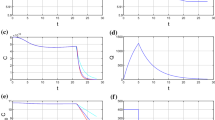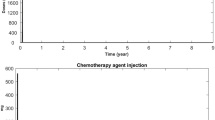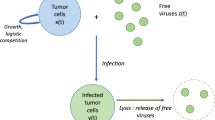Abstract
A mathematical model for combination therapy of glioma with oncolytic therapy and TNF-\(\alpha \) inhibitors is analyzed as an optimal control problem. In the objective, a weighted average between the tumor volume and the total amount of viruses given is minimized. It is shown that optimal controls representing the virus administration are generically of the bang-bang type, i.e., the virus should be applied at maximal allowed dose with possible rest periods. On the other hand, optimal controls representing the dosage of TNF-\(\alpha \) inhibitors follow a continuous regimen of concatenations between pieces that lie on the boundary and in the interior of the control set.


Similar content being viewed by others
References
Csatary, L.K., Gosztonyi, G., Szeberenyi, J., Fabian, Z., Liszka, V., Bodey, B., Csatary, C.M.: MTH-68/H oncolytic viral treatment in human highgrade gliomas. J. Neurooncol. 67, 83–93 (2004)
Lorence, R.M., Pecora, A.L., Major, P.P., Hotte, S.J., Laurie, S.A., Roberts, M.S., Groene, W.S., Bamat, M.K.: Overview of phase I studies of intravenous administration of PV701, an oncolytic virus. Curr. Opin. Mol. Ther. 5, 618–624 (2003)
Markert, J.M.: Conditionally replicating herpes simplex virus mutant, G207 for the treatment of malignant glioma: results of a phase I trial. Gene Ther. 7, 867–874 (2000)
Chiocca, E.A.: Oncolytic viruses. Nat. Rev. Cancer 2, 938–50 (2002)
Fulci, G., Breymann, L., Gianni, D., Kurozomi, K., Rhee, S.S., Yu, J., Kaur, B., Louis, D.N., Weissleder, R., Caligiuri, M.A., Chiocca, E.A.: Cyclophosphamide enhances glioma virotherapy by inhibiting innate immune responses. Proc. Natl. Acad. Sci. PNAS 103(34), 12873–12878 (2006)
Friedman, A., Tian, J., Fulci, G., Chioca, E., Wang, J.: Glioma virotherapy: effects of innate immune suppression and increased viral replication capacity. Cancer Res. 66(4), 2314–2319 (2006)
Auffinger, B., Ahmed, A.U., Lesniak, M.S.: Oncolytic virotherapy for malignant glioma: translating laboratory insights into clinical practice. Front. Oncol. (2013). https://doi.org/10.3389/fonc.2013.00032
Ratajczyk, E., Ledzewicz, U., Leszczyński, M., Friedman, A.: The role of TNF-alpha inhibitor in Glioma virotherapy: a mathematical model. Math. Biosci. Eng. 14(1), 305–319 (2017)
Ratajczyk, E., Ledzewicz, U., Leszczyński, M., Schättler, H.: Treatment of Glioma with virotherapy and TNF-\(\alpha \) inhibitors: analysis as a dynamical system. Discrete Contin. Dyn. Syst. Ser. B, 23(1), to appear (2018)
Bajzer, Z., Carr, T., Josić, K., Russell, S.J., Dingli, D.: Modeling of cancer virotherapy with recombinant viruses. J. Theor. Biol. 252(1), 109–122 (2008)
Crivelli, J.J., Földes, J., Kim, P.S., Wares, J.: A mathematical model for cell-cycle specific cancer virotherapy. J. Biol. Dyn. 6, 104–120 (2012)
El-alami Laaroussi, A., El Hia, M.E., Rachik, M., Benlahmar, E., Rachik, Z.: Analysis of a mathematical model for treatment of cancer with oncolytic virotherapy. Appl. Math. Sci 8, 929–940 (2014)
Kogan, Y., Forys, U., Shukron, O., Kronik, N., Agur, Z.: Cellular immunotherapy for high grade gliomas: mathematical analysis deriving efficacious infusion rates based on patient requirements. SIAM J. App. Math. 70, 1953–1976 (2010)
Wares, J.R., Crivelli, J.J., Yun, C., Choi, I., Gevertz, J.L., Kim, P.S.: Treatment strategies for combining immunostimulatory oncolytic virus therapeutics with dendritic cell injections. Math. Biosci. Eng. 12(6), 1237–1256 (2015)
Forys, U., Waniewski, J., Zhivkov, P.: Anti-tumor immunity and tumor anti-immunity in a mathematical model of tumor immunotherapy. J. Biol. Syst. 14, 13–30 (2006)
dOnofrio, A.: A general framework for modelling tumor-immune system competition and immunotherapy. Phys. D 208, 202–235 (2005)
Eisen, M.: Mathematical Models in Cell Biology and Cancer Chemotherapy Lecture Notes in Biomathematics, vol. 30. Springer, Berlin (1979)
Swan, G.W.: General applications of optimal control theory in cancer chemotherapy, IMA. J. Math. Appl. Med. Biol. 5, 303–316 (1988)
Swan, G.W.: Role of optimal control in cancer chemotherapy. Math. Biosci. 101, 237–284 (1990)
Swierniak, A.: Optimal treatment protocols in leukemia - modelling the proliferation cycle. In: Proceedings of 12th IMACS World Congress, Paris, 4, pp. 170–172 (1988)
Swierniak, A., Ledzewicz, U., Schättler, H.: Optimal control for a class of compartmental models in cancer chemotherapy. Int. J. Appl. Math. Comp. Sci. 13, 357–368 (2003)
Ledzewicz, U., Schättler, H.: Analysis of a cell-cycle specific model for cancer chemotherapy. J. Biol. Syst. 10, 183–206 (2002)
Ledzewicz, U., Schättler, H.: Optimal bang-bang controls for a 2-compartment model in cancer chemotherapy. J. Optim. Theory Appl. 114, 609–637 (2002)
Ledzewicz, U., Schättler, H.: Antiangiogenic therapy in cancer treatment as an optimal control problem. SIAM J. Control Optim. 46(3), 1052–1079 (2007)
Ledzewicz, U., Schättler, H.: A synthesis of optimal controls for a model of tumor growth under angiogenic inhibitors. In: Proceedings of 44th IEEE Conference on Decision and Control, Sevilla, Spain, pp. 934–939 (2005)
dOnofrio, A., Ledzewicz, U., Maurer, H., Schättler, H.: On optimal delivery of combination therapy for tumors. Math. Biosci. 222, 13–26 (2009)
Ledzewicz, U., Schättler, H.: Multi-input optimal control problems for combined tumor anti-angiogenic and radiotherapy treatments. J. Optim. Theory Appl. 153, 195224 (2012)
dOnofrio, A., Ledzewicz, U., Schättler, H.: On the dynamics of tumor immune system interactions and combined chemo- and immunotherapy. In: dOnofrio, A., Cerrai, P., Gandolfi, A. (eds.) New Challenges for Cancer Systems Biomedicine, SIMAI Springer series, Vol. 1, pp. 249–266 (2012)
de Pillis, L.G., Radunskaya, A.: A mathematical tumor model with immune resistance and drug therapy: an optimal control approach. J. Theor. Med. 3, 79–100 (2001)
Pontryagin, L.S., Boltyanskii, V.G., Gamkrelidze, R.V., Mishchenko, E.F.: The Mathematical Theory of Optimal Processes. Macmillan, New York (1964)
Bonnard, B., Chyba, M.: Singular Trajectories and their Role in Control Theory, Mathématiques & Applications, vol. 40. Springer, Paris (2003)
Bressan, A., Piccoli, B.: Introduction to the Mathematical Theory of Control. American Institute of Mathematical Sciences, San Jose (2007)
Schättler, H., Ledzewicz, U.: Geometric Optimal Control. Springer, New York (2012)
Bryson, A.E., Ho, Y.C.: Applied Optimal Control. Hemisphere Publ. Co., Washington (1975)
Ratajczyk, E.: Dynamics and Optimal Control of a Mathematical Model for Combination Therapy of Glioma. Ph.D. thesis at Lodz University of Technology, Lodz, Poland (2017)
Golubitsky, M., Guillemin, V.: Stable Mappings and their Singularities. Springer, New York (1973)
Schättler, H., Ledzewicz, U.: Optimal Control for Mathematical Models of Cancer Therapies. Springer, New York (2015)
Leszczyński, M., Ratajczyk, E., Ledzewicz, U., Schättler, H.: Sufficient conditions for optimality for a mathematical model of drug treatment with pharmacodynamics. Opuscula Math. 37(3), 403–419 (2017)
Acknowledgements
U. Ledzewicz’s research was partially supported by the National Science Foundation under collaborative research Grants No. DMS 1311733. Any opinions, findings, and conclusions or recommendations expressed in this material are those of the author(s) and do not necessarily reflect the views of the National Science Foundation.
Author information
Authors and Affiliations
Corresponding author
Additional information
Alberto d’Onofrio.
Rights and permissions
About this article
Cite this article
Ratajczyk, E., Ledzewicz, U. & Schättler, H. Optimal Control for a Mathematical Model of Glioma Treatment with Oncolytic Therapy and TNF-\(\alpha \) Inhibitors. J Optim Theory Appl 176, 456–477 (2018). https://doi.org/10.1007/s10957-018-1218-4
Received:
Accepted:
Published:
Issue Date:
DOI: https://doi.org/10.1007/s10957-018-1218-4




